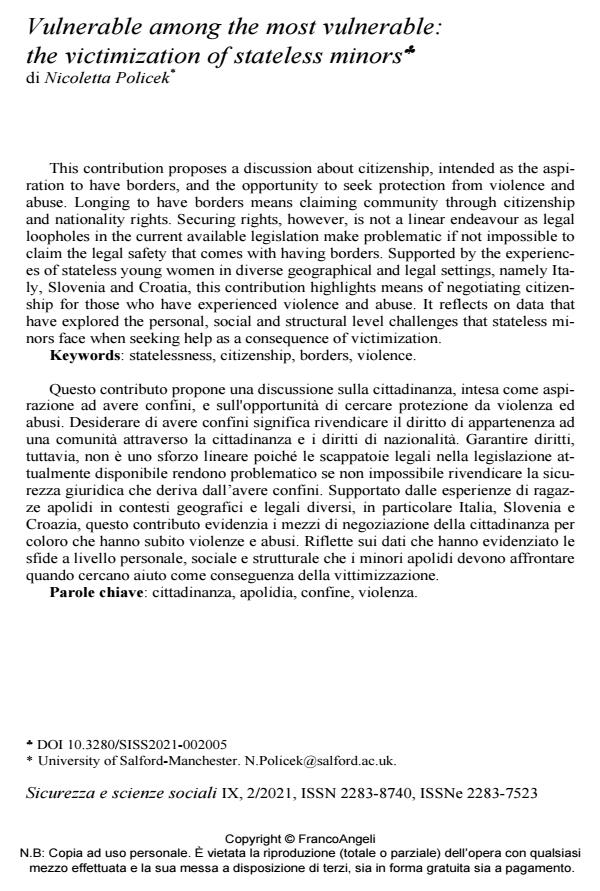Vulnerable among the most vulnerable: the victimization of stateless minors
Titolo Rivista SICUREZZA E SCIENZE SOCIALI
Autori/Curatori Nicoletta Policek
Anno di pubblicazione 2021 Fascicolo 2021/2
Lingua Inglese Numero pagine 14 P. 71-84 Dimensione file 162 KB
DOI 10.3280/SISS2021-002005
Il DOI è il codice a barre della proprietà intellettuale: per saperne di più
clicca qui
Qui sotto puoi vedere in anteprima la prima pagina di questo articolo.
Se questo articolo ti interessa, lo puoi acquistare (e scaricare in formato pdf) seguendo le facili indicazioni per acquistare il download credit. Acquista Download Credits per scaricare questo Articolo in formato PDF

FrancoAngeli è membro della Publishers International Linking Association, Inc (PILA)associazione indipendente e non profit per facilitare (attraverso i servizi tecnologici implementati da CrossRef.org) l’accesso degli studiosi ai contenuti digitali nelle pubblicazioni professionali e scientifiche
This contribution proposes a discussion about citizenship, intended as the aspi-ration to have borders, and the opportunity to seek protection from violence and abuse. Longing to have borders means claiming community through citizenship and nationality rights. Securing rights, however, is not a linear endeavour as legal loopholes in the current available legislation make problematic if not impossible to claim the legal safety that comes with having borders. Supported by the experi-ences of stateless young women in diverse geographical and legal settings, namely Italy, Slovenia and Croatia, this contribution highlights means of negotiating citi-zenship for those who have experienced violence and abuse. It reflects on data that have explored the personal, social and structural level challenges that stateless minors face when seeking help as a consequence of victimization.
Questo contributo propone una discussione sulla cittadinanza, intesa come aspirazione ad avere confini, e sull'opportunità di cercare protezione da violenza ed abusi. Desiderare di avere confini significa rivendicare il diritto di appartenenza ad una comunità attraverso la cittadinanza e i diritti di nazionalità. Garantire dirit-ti, tuttavia, non è uno sforzo lineare poiché le scappatoie legali nella legislazione attualmente disponibile rendono problematico se non impossibile rivendicare la sicurezza giuridica che deriva dall’avere confini. Supportato dalle esperienze di ra-gazze apolidi in contesti geografici e legali diversi, in particolare Italia, Slovenia e Croazia, questo contributo evidenzia i mezzi di negoziazione della cittadinanza per coloro che hanno subito violenze e abusi. Riflette sui dati che hanno evidenzia-to le sfide a livello personale, sociale e strutturale che i minori apolidi devono af-frontare quando cercano aiuto come conseguenza della vittimizzazione.
Parole chiave:cittadinanza, apolidia, confine, violenza.
Nicoletta Policek, Vulnerable among the most vulnerable: the victimization of stateless minors in "SICUREZZA E SCIENZE SOCIALI" 2/2021, pp 71-84, DOI: 10.3280/SISS2021-002005